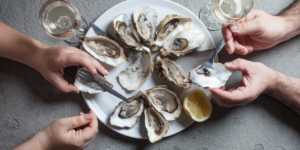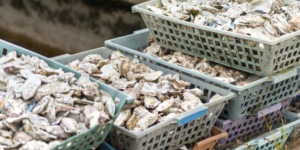From the rugged coasts of Maine to the sun-soaked shores of Florida, the United States boasts a rich tapestry of oyster farming traditions. Each region’s distinct climate, geography, and culture have given rise to unique methods and practices that have shaped the way oysters are cultivated and harvested.

Today we will dive into the world of oyster farming across Maine, Florida, California, Long Island, North Carolina, Texas, and the Chesapeake Bay.
Oyster Farming in Maine: The Northern Gem
Maine’s icy waters and bracing winters form the backdrop for a thriving oyster industry. Here, oysters are cultivated using the rack and bag method. Oyster farmers suspend bags of oysters on racks just beneath the water’s surface.
This technique protects the oysters from predators and ensures they grow plump and flavorful. The cold waters also contribute to slow growth, resulting in a more robust shell and rich taste. Maine’s unique climate lends a distinct flavor profile to the oysters, characterized by their briny, crisp, and slightly sweet taste.

Oyster Farming in Florida: Sunshine and Subtlety
In the warmth of Florida’s waters, oyster farming takes on a different approach. The Sunshine State primarily relies on aquaculture and suspended culture methods. Oyster farmers use floating cages or trays to grow their oysters, taking advantage of the subtropical climate and abundant sunlight.
This method accelerates growth, yielding oysters with a tender texture and a milder, slightly buttery flavor. Florida’s oysters often showcase a delicate balance of sweetness and salinity, reflecting the region’s unique coastal environment.
Oyster Farming in California: The Pacific Influence
California’s oyster farming story is deeply intertwined with the Pacific Ocean. The state utilizes a mix of methods, including rack and bag systems, floating trays, and even intertidal cultivation. California’s oysters are celebrated for their clean, crisp taste, influenced by the cold, nutrient-rich waters of the Pacific.
Oyster farmers here take advantage of the coastal upwelling, which brings forth a profusion of plankton, contributing to the oysters’ distinct flavor profile and vibrant color.
Oyster Farming in Long Island: A Maritime Legacy
Long Island’s oyster farming tradition dates back centuries, shaped by the region’s maritime heritage. Oyster beds dot the waters around the island, where farmers employ a combination of bottom planting and floating trays. The local oysters exhibit a briny and mineral-rich taste, influenced by the Atlantic Ocean’s mingling currents.
Long Island’s proximity to New York City ensures a steady demand, making its oyster farming industry a crucial part of the region’s culinary landscape.

Oyster Farming in North Carolina: Southern Hospitality, Oyster Style
North Carolina’s oyster farming scene captures the essence of Southern hospitality. Oyster farmers employ various techniques, such as bottom planting, rack and bag systems, and even innovative floating cages. The state’s warm waters foster rapid oyster growth, resulting in plump, juicy specimens.
North Carolina oysters are revered for their balanced flavors, a harmonious blend of saltiness and sweetness that reflects the region’s diverse estuarine ecosystems.
Oyster Farming in Texas: Bigger in Every Way
Everything is bigger in Texas, including its oyster farming endeavors. Texas combines traditional methods like bottom planting with modern aquaculture techniques.
The Lone Star State’s oysters are known for their hearty size and bold flavors, influenced by the Gulf of Mexico’s fertile waters. They often showcase a robust, briny taste that pairs perfectly with Texan culinary traditions.
Oyster Farming in Chesapeake Bay: A Historic Legacy
Chesapeake Bay’s oyster farming legacy harkens back to colonial times. Here, both wild harvest and aquaculture methods thrive. Oyster farmers use various methods, including bottom planting, cage culture, and floating trays.
The bay’s mix of freshwater and saltwater creates a unique environment that imparts a rich, complex taste to the oysters. Chesapeake Bay oysters are revered for their plumpness, buttery texture, and a flavor profile that reflects the bay’s natural diversity.
Tthe art of oyster farming in the United States is a testament to the nation’s geographical diversity and cultural richness. From the brisk waters of Maine to the balmy shores of Florida, each region contributes its unique flair to the world of oysters. As we traverse the coasts, one thing becomes clear: while the methods may differ, the passion for cultivating these briny treasures unites oyster farmers across the country, ensuring that each shell carries the essence of its origin.



